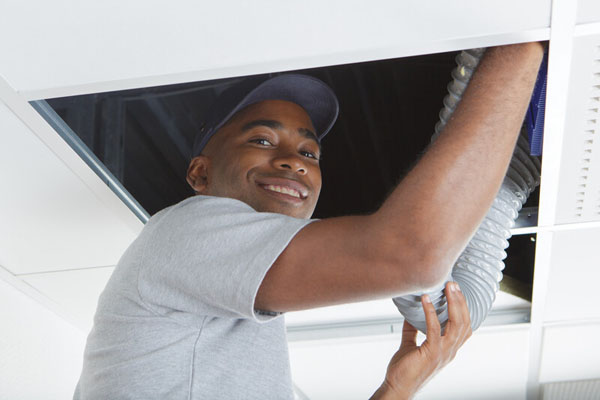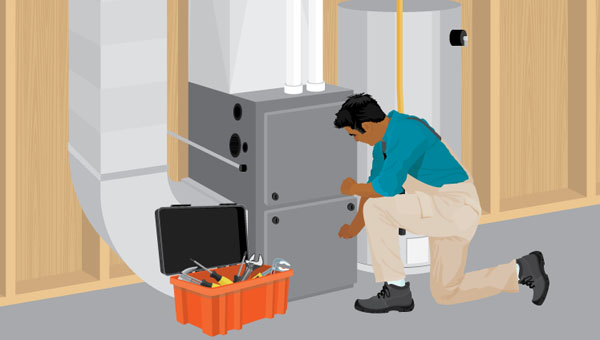By Lee Wallender
Contributing Writer
 Nothing is worse than having your furnace break down in the throes of winter. Swirling snow and dancing leaves are only charming when you are warm and cozy indoors. Winter’s beauty becomes a dismal sight when your home’s interior temperature is slowly dipping and area repair technicians are too busy to even take your call.
Nothing is worse than having your furnace break down in the throes of winter. Swirling snow and dancing leaves are only charming when you are warm and cozy indoors. Winter’s beauty becomes a dismal sight when your home’s interior temperature is slowly dipping and area repair technicians are too busy to even take your call.
Instead of waiting for a furnace technician, be the furnace technician. Your furnace technician assesses a downed furnace’s problems with a set of simple cues: sight, feel, smell, and sound. From that initial assessment, the technician further identifies and fixes components that caused these signals to happen in the first place. You can do the same thing.
Not all furnace issues can be repaired by the homeowner, though. So, with this guide, you will also learn to distinguish furnace problems that do require expert attention.
How to Inspect Your Furnace
Year after year, your furnace faithfully does its job. When the thermostat gives the signal, the furnace turns on, heats up, and blows warm air through your house. It does this day in, day out. In the heart of winter, it may be running 24 hours a day. In cold locales, it may be on constantly from late September to early April. That is quite a lot to ask of a machine. And when is the last time you actually looked at it?
When you go to the furnace room, keep your senses in tune because you will be using all of them. Bring a bright flashlight. Make sure the thermostat is turned up high enough so that the furnace will be running.
Here is what you should experience if your furnace is running in tip-top condition.
What You Will See
Around the furnace, the floor and walls will be relatively clean. Dust around the furnace will be normal furnace room or basement debris – mouse droppings, dust, cobwebs, etc. It will not be sooty or the by-product of combustion.
The flue will be straight, undented, with no gaps or holes.
When you look at the pilot light and flame (for gas furnaces), you will see a steady blue flame. In the motor area, the fan belt will be solid and pliable (not hard and cracked).
What You Will Touch
While there will be an imbalance in temperatures between different heating registers, this should not be a gross imbalance.
If you have access, feel the side of your warm air duct at various points down the line to assess temperature drop-off. The side of your return air duct will always feel cool to the touch.
Turn off electricity to your furnace by flipping the kill switch or turning off the circuit breaker. When you reach into the motor area and press on the furnace blower fan belt, it should feel firm and will depress about 1/4-inch or less.
What You Will Smell
Ideally, you will smell nothing. But it is common to smell singed dust, especially during the first heating cycle of cold season or after you come back from a long vacation during cold season. Dust that has collected on the heating element is burned off, producing a slightly pungent odor that dissipates quickly, usually in less than 20 minutes.
It is also common for a furnace to smell musty. Filters can get moldy, and when air is passed through them, this smell is dispersed throughout the house and should go away soon.
What You Will Hear
When a furnace is operating properly, it will make plenty of sounds. In fact, sounds mean that your furnace is working the right way – but these have to be the right sounds.
The low, continuous whoosh of the draft inducer is the most common sound you will hear. It will precede the firing of the burners by about one minute in order to clear out combustion gasses from the previous heating cycle.
Popping and banging are typically related to the metal of the furnace housing or the metal ductwork cooling down and contracting, much like the hood of a car after the engine has been shut down.
Metallic rattling is common, but only from areas outside of the furnace itself – usually, heating registers rattling when air is being forced through them.
Identify by Sight
Many furnace problems can be diagnosed purely by visual inspection. Before even touching the furnace, check for:
- Correct Flame Color: The flame should be pure blue, not yellow or orange or even streaked with yellow or orange . Anything other than blue indicates partial combustion.
- Properly-Drawing Flue: The flue is the metal or PVC chimney that carries potentially toxic, partially combusted gasses from the furnace to the exterior. The furnace flue should be intact, undamaged, and with no holes or vermin activity.
- Normal Debris, Not Soot: You should not find ashes or gravely cinder-type soot anywhere near the combustion area of the furnace. If there is any debris, it should be the usual type found in furnace areas, such as cobwebs, dust, mouse droppings, etc.
- Relatively Clean Filter: All furnace filters are dirty; collecting debris is their job. But if your recently-changed filter is excessively clogged, the area near your return vent may be too dirty (such as near an exterior door).
Identify by Touch
Touch is another sense you can call into play to diagnose furnace issues.
Ducts: If you have access to both the return air and warm air ducts (such as in a basement or crawl space), touch both of them after the system has been running for ten minutes. The return air duct should be cool; the warm air duct will be hot near the furnace but warm farther down the line.
 Registers: Know where your heating registers are in relation to the furnace. There will always be an imbalance in temperatures between registers located nearest to the furnace compared to those farther away. But if distant registers are blowing room-temperature air, that is cause for concern. Ways to combat this: adding insulation around the warm air ducts; adding smart vents that open and close according to schedule; adding a second furnace; blocking off rooms that are used infrequently.
Registers: Know where your heating registers are in relation to the furnace. There will always be an imbalance in temperatures between registers located nearest to the furnace compared to those farther away. But if distant registers are blowing room-temperature air, that is cause for concern. Ways to combat this: adding insulation around the warm air ducts; adding smart vents that open and close according to schedule; adding a second furnace; blocking off rooms that are used infrequently.
Motor Fan Belt: With the electricity off, depress the fan motor pully belt. It should depress no more than 1/4-inch. If it depresses 1/2-inch or more, call a technician for repair assistance.
Identify by Smell
Furnaces draw in cool air from a central intake in your home, pull it through the return-air ducts, heat it, then send it back into the house via the warm-air plenum and ducts. With all of this exchange of air, it is natural that there will be odors, some worse than others.
Rotten Eggs
Because natural gas is odorless, utility companies add mercaptan so that homeowners will know if there is a gas leak. Mercaptan smells sulfuric, like rotten eggs. If you smell this, leave the house immediately and call the gas company for assistance.
Metallic; Burning Plastic or Rubber
A chemical-type or metallic smell of burning plastic or rubber around the furnace may indicate a problem with the fan belt or motor. Or it could mean that an electrical component is arcing. These are major concerns and should be addressed by a furnace technician immediately.
Pungent, Foul
When the odor is truly pungent, like rotting meat, this means you have a dead animal somewhere in the air exchange system. This smell will not go away for a very long time, so the animal must be removed and the area sterilized.
Urine
If you have pets and the smell of urine kicks up every time the furnace starts, this may mean that the pet has urinated on or near the intake vent.
Lingering Dusty Smell
Because the smell of burning dust should not persist beyond the first heating cycle or two, a lingering dusty smell is a cause of concern. Mold or fungus growth may have a dusty smell. Toxic Stachybotrys chartarum mold, otherwise known as black mold, can produce a dust-like substance.
Sewage
While not a common condition, a sewer smell when the furnace is running is annoying and difficult to pin down. Clean water that turns stagnant smells musty, so the source would have to be water that contains organic material: usually toilet sewage or kitchen waste. Either type of outflow may be leaking at any point in your return air ducts.
Identify by Sound
Furnaces make considerable noise, even the most efficient AFUE 97% models. But how much noise is too much and which noises should you expect?
Rushing/Whooshing: Furnaces are meant to blow air, so the sound of rushing air is expected. But when the whooshing is too loud, the cause might not be related to the furnace unit itself but to heating registers. If some heating registers are closed, even partially, this forces a greater volume of air through the remaining registers, producing that rushing sound. Open all heating registers and run the system. If the noise lessens, then you have located the cause.
Whistling: A high-pitched whistling sound usually means that air flow is restricted. Because air is not freely flowing from the vents, it must find other avenues of escape, namely through gaps in the ducts. A clogged air filter may produce a whistling sound near the furnace area, too.
Scraping Sound: Any sound coming from your furnace that is similar to metal scraping metal is one for concern. Turn off the furnace immediately. The cause may be that the blower wheel has come loose from the motor shaft or that it has broken under the strain of years of use. Another possibility is that the motor mount has loosened, allowing the motor to keep turning while hitting the sides of the furnace housing.
Booming or Backfiring: A low “explosion” noise coming from the furnace is usually what is called delayed ignition. Gas builds up in your furnace for a short time before the flame ignites it. This is a concerning and potentially dangerous issue; call a technician for assistance.
As a homeowner, you can troubleshoot and make basic repairs on your furnace. This guide helps you diagnose furnace issues by sight, sound, touch, and smell.
Lee Wallender began remodeling homes when he transformed a World War I-era farmhouse into a comfortable new home. He has been writing about home remodeling on About Home Renovations since 2006.
 Pride News Canada's Leader In African Canadian & Caribbean News, Views & Lifestyle
Pride News Canada's Leader In African Canadian & Caribbean News, Views & Lifestyle





